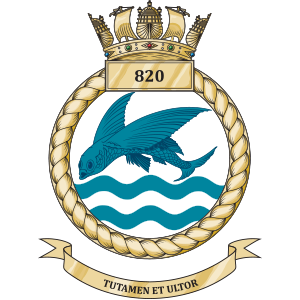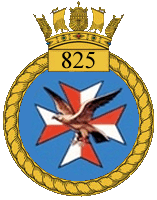| 823 Naval Air Squadron | |
|---|---|
| Active | 1933–1945 |
| Country | |
| Branch | |
| Type | Carrier based squadron |
| Role | Offensive Support |
| Part of | Fleet Air Arm |
| Battle honours | Norway 1940 |
823 Naval Air Squadron was a Fleet Air Arm aircraft squadron before and during World War II.
| 823 Naval Air Squadron | |
|---|---|
| Active | 1933–1945 |
| Country | |
| Branch | |
| Type | Carrier based squadron |
| Role | Offensive Support |
| Part of | Fleet Air Arm |
| Battle honours | Norway 1940 |
823 Naval Air Squadron was a Fleet Air Arm aircraft squadron before and during World War II.
823 squadron was formed on 3 April 1933 by a merger of No's 441 and 448 (Fleet Spotter Reconnaissance) Flights aboard HMS Glorious, a cruiser converted to an aircraft carrier in the 1920s. The new squadron was equipped with Fairey IIIFs and served in the Mediterranean. Following a ship refit the squadron split its aircraft between HMS Courageous and Glorious when they sailed to the Mediterranean in August 1935 in response to the Abyssinian crisis. The squadron, now re-equipped with Fairey Swordfish, was transferred to Admiralty control in 1940.
In the early part of the war, the squadron sailed aboard HMS Glorious into the Red Sea and Indian Ocean to attack enemy shipping, returning to the Mediterranean in Jan 1940. They operated from Hal Far, Malta until March 1940, until they were needed to take part in the defence of Norway. There HMS Glorious was sunk by the German battleships Gneisenau and Scharnhorst on 8 June 1940, and half of the squadron (5 aircraft) lost. The remainder flew from RNAS Hatston with 821 Squadron on 21 June 1940 to attack Scharnhorst, with little or no success. On 24 July 1940 they attacked enemy destroyers and shipping off Norway but were disbanded at Hatston in December 1940.
In November 1941 the squadron was reformed at Crail airfield in Fife, Scotland as a torpedo bomber reconnaissance (TBR) Swordfish squadron, subsequently sailing on HMS Furious in August 1942 with 9 Albacores for convoy duties. In September 1942 the squadron was attached to No 16 Group, Coastal Command at RAF Manston and RAF Tangmere for anti-submarine patrols in the English Channel.
In June 1943 the squadron was re-equipped with Fairey Barracuda IIs at Lee-on-Solent and joined the 11th TBR Wing in southern India. They were finally disbanded in July 1944 at Katukurunda Airport after being merged with 822 squadron.

| From | To | Aircraft | Version | Notes |
|---|---|---|---|---|
| Apr 1933 | Dec 1934 | Fairey IIIF | Based aboard HMS Glorious | |
| Dec 1934 | Dec 1936 | Fairey Seal | Based aboard HMS Glorious | |
| Nov 1936 | April 1942 | Fairey Swordfish | I | |
| April 1942 | May 1943 | Fairey Albacore | I | |
| June 1943 | July 1944 | Fairey Barracuda | II |

The Fairey Swordfish is a biplane torpedo bomber, designed by the Fairey Aviation Company. Originating in the early 1930s, the Swordfish, nicknamed "Stringbag", was principally operated by the Fleet Air Arm of the Royal Navy. It was also used by the Royal Air Force (RAF), as well as several overseas operators, including the Royal Canadian Air Force (RCAF) and the Royal Netherlands Navy. It was initially operated primarily as a fleet attack aircraft. During its later years, the Swordfish was increasingly used as an anti-submarine and training platform. The type was in frontline service throughout the Second World War.

HMS Glorious was the second of the three Courageous-class battlecruisers built for the Royal Navy during the First World War. Designed to support the Baltic Project championed by the First Sea Lord, Lord Fisher, they were relatively lightly armed and armoured. Glorious was completed in late 1916 and spent the war patrolling the North Sea. She participated in the Second Battle of Heligoland Bight in November 1917 and was present when the German High Seas Fleet surrendered a year later.

The Fairey Albacore is a single-engine biplane torpedo bomber designed and produced by the British aircraft manufacturer Fairey Aviation. It was primarily operated by the Royal Navy Fleet Air Arm (FAA) during the Second World War.

811 Naval Air Squadron was a unit of the British Royal Navy's Fleet Air Arm. It was first founded in 1933, and served during World War II, seeing action in the battle of the Atlantic and on Russian convoys, and was eventually disbanded in 1956.
835 Naval Air Squadron was a former squadron of the Royal Navy's Fleet Air Arm originally formed in February 1942 as a torpedo bomber and reconnaissance unit flying Fairey Swordfish. In June 1943, six Sea Hurricanes were added to the squadron as a fighter flight. The composite unit exchanged the Hurricanes in September 1944 for Grumman Wildcats, serving on until 1 April 1945, when the squadron disbanded.

800 Naval Air Squadron was a Royal Navy Fleet Air Arm carrier-based squadron formed on 3 April 1933 by amalgamating No's 402 and 404 Flights.

Royal Naval Air Station Hatston, was a Royal Naval Air Station, one mile to the north west of Kirkwall on the island of Mainland, Orkney, Scotland. It was located near the strategically vital naval base of Scapa Flow, which for most of the twentieth century formed the main base of the ships of the Home Fleet. The airbase was designed to provide accommodation for disembarked Front-Line squadrons and accommodation for disembarked Ship's Flight Aircraft and was home to the Home Fleet Fleet Requirements Unit, 771 Naval Air Squadron.
806 Naval Air Squadron was a fighter squadron in the Fleet Air Arm that existed from February 1940 to December 1960 and saw active service in the Norwegian campaign, the Dunkirk evacuation and the Malta Convoys.

701 Naval Air Squadron was a Royal Navy Fleet Air Arm squadron, which last disbanded during September 1958 at RNAS Lee-on-Solent where it was a Helicopter Trials, Communications and Fleet Requirements Unit. It initially formed during July 1936 as a Catapult Flight operating out of Malta and routinely embarking in RN ships such as, HMS Barham, HMS Malaya, HMS Valiant and HMS Warspite. By autumn 1939 it was known as 701 Naval Air Squadron but disbanded in January 1940. It was active twice more during the Second World War, between May 1940 and June 1941 on special duties and then between October 1942 and August 1943 performing anti-submarine patrols. Reforming in April 1945 it was designated a Communications Unit, operating out of Heston until disbanding in 1947. It last reformed as a Fleet Requirements Unit at HMS Daedalus, Lee-on-Solent, during October 1957.

820 Naval Air Squadron is a Royal Navy Fleet Air Arm carrier-based squadron flying the AgustaWestland Merlin HM2 in Anti-Submarine and Airborne Early Warning (AEW) roles from RNAS Culdrose.
821 Naval Air Squadron was a Royal Navy Fleet Air Arm carrier based squadron formed on 3 April 1933 with the transferral and amalgamation of the Fairey III aircraft from 446 and half of 455 Flight Flights Royal Air Force to the newly formed Fleet Air Arm of the Royal Air Force. The squadron operated during the Second World War.
810 Naval Air Squadron was a Royal Navy Fleet Air Arm carrier based squadron formed on 3 April 1933 with the amalgamation of the 12 Blackburn Dart aircraft from 463 and 44 Flight Flights Royal Air Force to the Fleet Air Arm. The squadron saw action during the Second World War, the Suez Crisis and the Korean War.
818 Naval Air Squadron was a Royal Navy Fleet Air Arm carrier-based squadron formed in August 1939. It served on a number of the Navy's aircraft carriers during the Second World War, serving in most of the theatres of the war, before decommissioning at the end of the war.

825 Naval Air Squadron is a Royal Navy Fleet Air Arm Naval Air Squadron which was re-commissioned on 10 October 2014 and currently flies the AgustaWestland Wildcat HMA2.

828 Naval Air Squadron was a Royal Navy Fleet Air Arm carrier based squadron formed in September 1940 as a torpedo spotter reconnaissance squadron. It operated in a number of the theatres of the Second World War, carrying out a number of attacks on enemy targets including the Tirpitz in Norway.
812 Naval Air Squadron was a Naval Air Squadron of the British Royal Navy's Fleet Air Arm. It was active between 1933 and 1956, and saw service in both World War II and the Korean War.
822 Naval Air Squadron was a Fleet Air Arm aircraft squadron before and during World War II.

826 Naval Air Squadron was a Fleet Air Arm aircraft squadron formed during World War II which has been reformed several times since then until last disbanded in 1993.

Royal Naval Air Station Twatt, is a former Royal Navy Air Station located near Twatt, Orkney, Scotland. It was built by the Admiralty and was commissioned on 1 April 1941. On 1 January 1942 it became an independent command as HMS Tern. The airbase was designed to provide accommodation for disembarked Front-Line squadrons and accommodation for disembarked Ship's Flight Aircraft and was home to the Home Fleet Fleet Requirements Unit, 771 Naval Air Squadron.